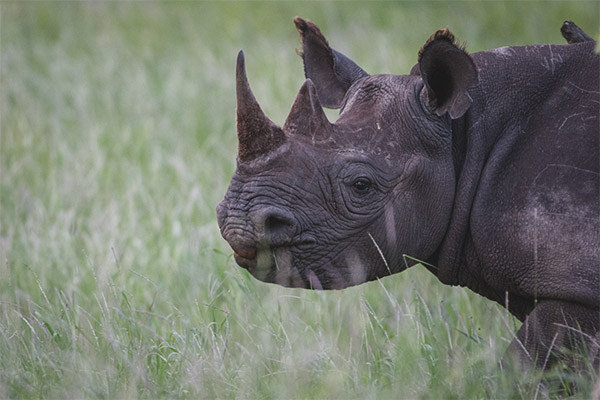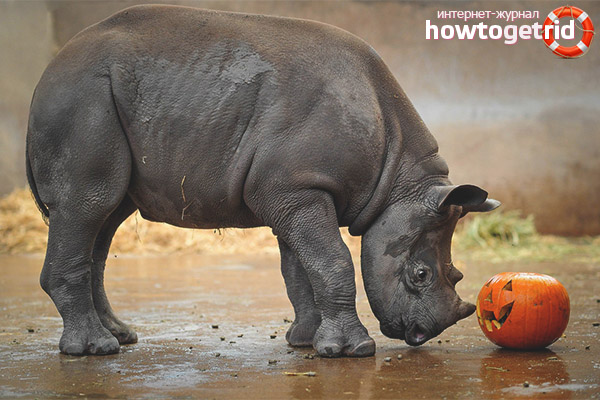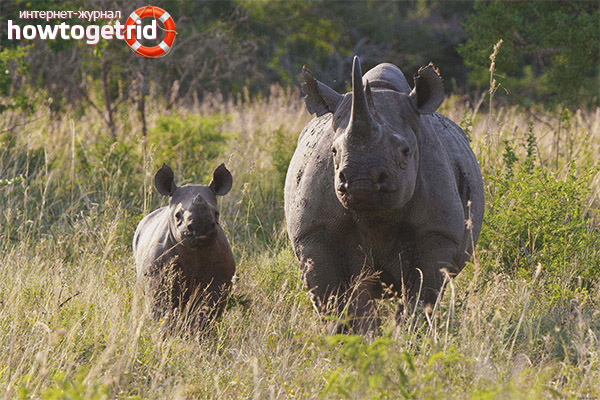The content of the article
In today's article we will study a representative of the rhinoceros family. It is ranked in the detachment of the equestrian, it is distinguished by its external characteristics and behavior. There are many varieties of rhinos, but we will consider the black representative. If you translate the name from Latin, it will sound like “nose, horn”. Individuals have a special structure, which is why a certain elongation is seen from the nasal bone, or even several. But let's not get ahead of ourselves, we will study the features in order.
Description and habitat
- By rhinoceros is meant a large land mammal, which is inferior in its overall characteristics only to an elephant. Along the length of the body, these individuals grow to 2.5–5 m. With a height at the withers of about 1.5–3 m. And a weight of about 1.3–3.5 tons. The name of the species reflects the color of the skin, in our case it is pigmented with black.However, there are brown-gray individuals that may appear black under certain lighting conditions.
- The rhinoceros quickly absorbs organic matter from the soil. If the animal is gray-brown, then after felting in the soil becomes black. The head of the representatives of the family is narrowed, the frontal part is lowered. Between the nose and forehead there is a depression, which somewhat resembles a saddle. In comparison with the head, this type of mammal has very small eyes. They are pigmented by brown or black, the pupils are oval in shape. Upper eyelids covered with thick dark cilia.
- Representatives of the family have a well-developed sense of smell. They rely more on their nose than other organs. The volume of the nasal cavity exceeds the size of the brain. These animals are famous for their excellent hearing. The structure of the ears resembles a tube that draws in even the quietest sounds. However, the sight of rhinos is disgusting, they do not rely on it. They can catch sharp movements, and fixed objects will be bypassed. And the vision works only on 30 m. Since the eyes are located from the side sections of the head, these individuals first involve one eye, then the other.
- The upper lip is distinguished by its mobility, hanging over the bottom.Jaws with incomplete teeth, but very strong. There are no canines, but each jaw is supplied with seven molars. They exude over the life cycle. There are sharp incisors in the lower section. A distinctive characteristic of these mammals is the horn, it grows from the frontal or nasal bone. A pair of growths pigmented with black or gray is usually observed.
- If a young growth gets into a fight and damages the horn, it will recover with age. However, elderly individuals cannot count on such an outcome, their horn cannot be restored. Black representatives of the family have 2–5 horns. The extremities of rhinos are powerful, with three fingers. At each of them there is a small hoof. It is very easy to recognize a mammal by its prints, since they are similar to clover leaves. The skin is devoid of hair, but hairs may be present at the ends of the ears. The tail grows up to 70 cm in length, has a thin structure and ends with a brush of hair.
- Often the individuals represented are in Tanzania, Namibia, Angola, Mozambique, Kenya, and the Republic of South Africa. They are also found in Zimbabwe, Zambia, Malawi.Rhinoceros like drought, they lodge in sparse, flattering terrain, groves, steppe zones, shrubs, savannas, deserts. Meet at an altitude of 2.5 km. above sea level. This species is on the verge of extinction, according to the data, there are about 4860 individuals.
Nutrition
- Animals prefer to stick to vegetarianism. They eat about 70 kg per day. food of plant origin. The basis of the diet is grass. Animals tear it off with powerful and mobile lips, also pick up the fallen leaves. Some individuals are not indifferent to the shoots of shrubs and trees. They can pry acacia with roots, absorbing it in a huge amount.
- The lip of the wedge-shaped format is otherwise called the proboscis. She breaks off the twigs. These mammals like elephant grass, they also eat aquatic vegetation and reed shoots. Favorite delicacy is sugar cane, they use bamboo, figs, mango.
- With regard to food in captivity, when the data of the family members are kept at the zoo, they are harvested hay and are treated to fresh grass. Be sure to add vitamin complexes.In feed add leaves and shoots.
- Power giants can occur regardless of the time of day. Black specimens predominantly eat in the morning and evening. As for the other rhinos, they can remain active both at night and during the day.
- During the day a huge animal can consume from 50 to 170 liters. water. Such indicators are highly dependent on the weather. During a drought, individuals are able to do without water for 4-5 days.
Lifestyle
- Often, mammals prefer a solitary lifestyle. Such animals do not form herds. We should also mention white rhinos, only they sometimes form small groups. As for females, they almost always exist together with the offspring for some time.
- Only in the mating season, different sexes can be together. Despite the fact that they prefer to lead a single lifestyle, these individuals even have true friends in nature. These are the birds - buffalo starlings. They constantly accompany rhinos and other ungulates.
- Rhinos value such small birds for feeding on ticks and other insects that climb onto their backs.Such birds warn large animals of the imminent danger with a loud cry. In ancient times, such birds were even called defenders of rhinos.
- In addition, when giants begin to take baths, turtles are eaten from their backs by ticks. In this way, they give the animals a huge favor. The rhinos themselves in the wild strictly follow their own territory and protect it. One individual has its own plot with a pond and pasture.
- Over the long years of life, the mammals in question are treading their paths towards water bodies. In such places, animals take mud baths. African rhinos even have separate restrooms. For a long time an impressive amount of manure is accumulated on individuals. With this fragrance they mark the limits of their own territory.
- The considered individuals try to mark their own territory not only with manure, but also with odorous marks. So do the old males. Tagging bushes and grass with urine. Black rhinos are active in the early morning. In addition, they often lead the same way of life at night. At this time, they are trying to get as much food as possible.
- In the daytime, rhinos prefer to sleep in the shade. They can nap on the side or the stomach. Sometimes they spend this time in mud baths. It is worth noting that the giants sleep is very strong, they completely forget about any danger. At this time, they can even sneak up on them. As for the other species, they are active night and day.
- It is noteworthy that the discussed giants are cautious in everything. They do not seek to make contact with people, and once again beware of them. But if the rhino feels dangerous, as a defense, he will definitely attack first. Surprisingly, such animals can accelerate to 45 km / h. However, they will not be able to run for a long time.
- The black rhino has a great temper. They quickly attack in which case and they simply can not be stopped. This can not be said about white rhinos. They are more peaceful and calm. If a person hands feed a baby, he will become tame at all.
Rhinos are quite an interesting species of animals. In the wild, these giants are better not to anger. Otherwise, the furious tank simply can not be saved. Otherwise, they are peaceful and fairly calm.The individuals kept in captivity remain fairly friendly.
Video: Black Rhino (Diceros bicornis)













To send